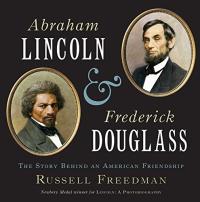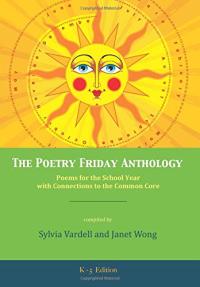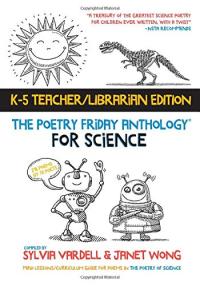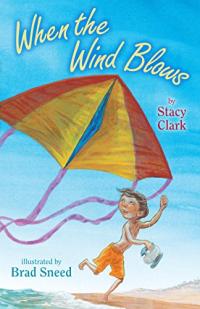
The poem encourages readers to “Spread your feathers,/sweep up the sun,/ride the wind and explore.” When combined with stunning photographs of birds, many in motion, the natural world comes into crisp focus for a unique, lyrical exploration of North American birds.
Sweep Up the Sun

Mr. Tiffin’s class studies similes, metaphors and different types of poetry in preparation for a visit from a real poet for the school-wide celebration of National Poetry Month. In sharing with Ms. Crane, Ellinor discovers that she holds a “poem in the pocket of my mind.” Child-like illustrations combine with a gentle story which dispels many misconceptions about poetry.
A Poem in Your Pocket

Nursery rhymes from around the globe are collected here with illustrations by more than 70 artists. The diversity of artistic styles, places of origin, and the combination of well and lesser known ditties (and additional verses) in a large format make this a book to share frequently.
Over the Hills and Far Away

Katy and her baby brother Olly go out and about through four seasons beginning with spring when “The birds are busy/And so am I.” Realistically rumpled children engage in recognizable activities are presented in short poems and the artist’s signature illustrations for a charming collection that celebrates childhood and the seasons.
Out and About: A First Book of Poems

Every day, young children and their families can celebrate familiar things and activities in this sturdy, handsome, and appealing collection of 30 poems. Each short piece by a range of poets is about food, family, firsts, play and bedtime, creating a memorable collection just right for the youngest listener.
Lullaby and Kisses Sweet: Poems to Love with Your Baby

Short poems about animals appear in English and Spanish accompanied by textured illustrations reminiscent of folk art. An author’s note reveals that she is neither a poet nor native Spanish speaking but was launched into both Spanish and poetry when she discovered the work of Pablo Neruda.
Flutter and Hum: Animal Poems / Aleteo y Zumbido: Poemas de Animales

An introduction presents an overview of the collection’s unique perspective: poetry from different historical periods connected by poems about objects. A range of poets and places are presented, each illustrated by loose watercolor illustrations. An opening poem by Eloise Greenfield entitled “Things” provides a lively start to this appealing collection.
The Death of the Hat: A Brief History of Poetry in 50 Objects

“Like horses at the starting gate,/We shift and shuffle — we can’t wait” for the bell that signals the end of the school day. Violin practice, homework, television, and more call on kids during the week and are presented in clever rhyming poems and humorous cartoon illustrations.
After the Bell Rings: Poems About After-School Time

Poetry Tag Time is a chain of poets and poems that makes language part of a playful game. When a poet is tagged, that poet must write a poem that connects with the previous poem. Part of the fun is the poet’s explanation of the sometimes whimsical “connection” between the two poems. See also the holiday-themed Gift Tag (opens in a new window).
Poetry Tag Time

The First World War comes into gritty focus through battles fought and the world changes it brought about. Photographs and other primary source material make this a riveting, sophisticated look at an impactful period in world history.
The War to End All Wars: World War I

From a shy child, Eleanor grew up to be an activist and a quietly powerful First Lady. Her life is chronicled in an understandable, well documented narrative complemented by an array of photographs. This is a solid companion to Freedman’s biography of Eleanor’s husband, Franklin Delano Roosevelt (opens in a new window).
Eleanor Roosevelt: A Life of Discovery

Martha Graham was tenacious; she was a dancer with a vision who left her mark on the modern American dance. Her life and art combine in this highly readable biography revealed through photographs and narrative which incorporates interviews with those who knew her.
Martha Graham: A Dancer’s Life

Powerful portraits of six Indian leaders of western tribes are presented in a handsome volume. Photographic portraits and other visuals from the period enhance the well-documented, highly readable biographies of well and lesser known chiefs.
Indian Chiefs

Fifty years ago well-known civil rights leaders came together with other lesser known but key individuals in Selma, Alabama. Events leading to breaking down the barriers to voting rights for African Americans are detailed through strong images and moving, well-documented narrative.
Because They Marched

Abraham Lincoln comes to life as a leader, a husband and a father in this enthralling account of his life and the times in which he lived. Lincoln’s writing and other primary sources are seamlessly incorporated along with telling photographs.
Lincoln: A Photobiograhy

The East Coast had Ellis Island, comparable to the West Coast’s Angel Island in the San Francisco Bay. There immigrants, primarily Chinese, entered the U.S. from about 1910 to 1940 where they stayed sometimes for long periods. Primary sources, both text and image, combine for a poignant portrait of the people and the period.
Angel Island: Gateway to Gold Mountain

Though different, Abraham Lincoln and formerly enslaved Frederick Douglass shared a great deal in common. Both came from poverty, achieved prominence; they developed camaraderie and a shared vision that changed a nation, all presented in this clear and accessible volume.
Abraham Lincoln and Frederick Douglass: The Story Behind an American Friendship

Poetry expert Vardell shows how librarians, teachers, and others can introduce children, ages 5 to 12, to the world of poetry in a way that’s meaningful, participatory, and fun. The book offers practical strategies for reading aloud and teaching poetry in both formal and informal situations; details best practices gleaned from years in the field, with numerous suggestions that cross the curriculum from literature to science and math; and includes expanded lists of poems, poet profiles, book-poetry pairings, and other tools useful for programming and collection development.
Poetry Aloud Here: Sharing Poetry With Children

This guide offers an action-oriented approach for sharing books with children ages 5 through 12, planning book-based programs, and collaborating with teachers and families in sharing books and developing literature-based instruction. The contents address seven major genres: picture books, traditional tales, poetry, contemporary realistic fiction, historical fiction, fantasy, and informational books.
Children’s Literature in Action: A Librarian’s Guide

This anthology offers a set of 36 poems for each grade level, K-5 (a poem-a-week for the 9 months of the typical school year). Activities are poem-specific, skill-based, developmentally appropriate for each weekly poem — and that connect to the Common Core standards for poetry instruction. Infuse poem-sharing throughout the day and throughout the curriculum. And don’t be surprised if it’s a wonderful poem moment that students remember most vividly at the end of the school year!
The Poetry Friday Anthology: Poems for the School Year with Connections to the Common Core

This anthology features 218 poems by 78 award-winning and popular poets, connecting science with reading and language arts. The “Take 5!” activities highlight concepts and topics identified in the Next Generation Science Standards and incorporate the literacy skills identified in the Common Core State Standards.
The Poetry Friday Anthology for Science: Poems for the School Year Integrating Science, Reading, and Language Arts

A grandmother and her grandson enjoy flying a kite on a windy spring day near their seaside home. Lush, textured illustrations show the landscape and animal inhabitants and the way wind plays with hats. Staccato rhymes chronicle the joy-filled day that ends with a shower.
When the Wind Blows

Many things happen when the wind blows. Dune grass bends, waves spray, and “Copper whirls ‘round/Between two magnets/High aboveground” to generate electricity that is used to power our nation. Lyrical text and realistic illustrations provide a creative introduction to wind power.
When the Wind Blows

Forest animals “live as neighbors” and survive by building. The homes and their inhabitants are presented in stunning, earth-toned pop-ups accompanied by a brief but informative and engaging text.
